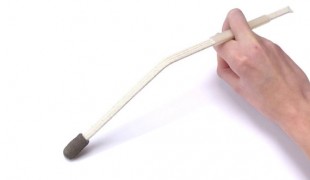- 9750
- 594
- 12
- 13
- 0
- Help Ukraine
About the solution
The Frankenkindle is a modified Kindle which allows Glenn’s sister to easily use her Kindle without being affected by the difficulties caused by her cerebral palsy.
The tiny buttons in particular were extremely difficult to use but as the video at the bottom of the page from Glenn’s blog shows, it was an extremely technical process on his part to create the accessible eBook reader.
Glenn used the large controls from a children’s eBook reader (produced by VTech) as he realised the controls on this reader were much easier to use but the reader itself only held children’s books. Using his engineering prowess Glenn was able to both mount the Kindle and hack its content so as to reroute the controls to the VTech controller pad making it accessible for his sister.
“Functionally it's complete, but there's still a fair bit to be done to make it more robust. The Kindle itself needs to be semi-permanently mounted to the front panel rather than just resting on two wood screws. The circular interface board along with the flat cable connecting it to the Kindle are both quite fragile and will need to be covered. Finally, the cables will need to be routed in a more organized fashion”, he explained.
More info: http://bit.ly/2grS9Zz
Adapted from: http://bit.ly/2bZnqFh
What about you, do you have any solutions? Please share them with the Patient Innovation community!
https://www.youtube.com/watch?v=roplxL3SgTg
这些解决方案不应包括使用药物,化学品或生物制品(包括食品);创伤性设备;冒犯性的,商业或内在危险的内容。该解决方案未经医学验证。请谨慎进行!如果您有任何疑问,请咨询健康专家。
DISCLAIMER: This story was written by someone who is not the author of the solution, therefore please be advised that, although it was written with the utmost respect for the innovation and the innovator, there can be some incorrect statements. If you find any errors please contact the patient Innovation team via info@patient-innovation.com
-
-
483
-
0
-
6072

Wheelchair user creates mobility app
MOVING IN A WHEELCHAIR: Moving using a wheelchair.
Paralysis
App (Including when connected with wearable)
Restoring mobility
Promoting self-management
Managing Neurological Disorders
Building Supportive Community Relationships
Promoting inclusivity and social integration
Preventing (Vaccination, Protection, Falls, Research/Mapping)
Raise awareness
Caregiving Support
Internal Medicine
Neurology
Orthopedics
Physical Medicine and Rehabilitation
Rheumatology
Belgium
-
-
-
738
-
0
-
12116

Tablet accessories for disabled users
Writing (letters, songs, peoms)
Neuromuscular Disorders
Assistive Technology access
Tremors
Muscle cramps or spasms
Difficulty coordinating movements
Stiffness or rigidity (difficulty moving)
Muscle weakness
Trouble with fine motor skills (e.g., writing, buttoning clothes)
Numbness or tingling in the extremities
Twitching or involuntary movements (myoclonus)
Replacing lost limbs
Promoting self-management
Managing Neurological Disorders
Promoting inclusivity and social integration
Neurology
Orthopedics
Rheumatology
Netherlands
-
-
-
562
-
0
-
11619

Man invents stick to help him push the elevator buttons
MOVING IN A WHEELCHAIR: Moving using a wheelchair.
Urban exploration
Traveling
Paralysis
Spinal Cord and Nerve Root Disorders
Cervical spinal cord injury/Tetraplegia
Assistive Daily Life Device (to help ADL)
Tremors
Muscle cramps or spasms
Difficulty coordinating movements
Stiffness or rigidity (difficulty moving)
Paralysis of the legs and lower body
Muscle weakness
Loss of balance
Numbness or tingling in the extremities
Twitching or involuntary movements (myoclonus)
Fatigue
Restoring mobility
Promoting self-management
Managing Neurological Disorders
Promoting inclusivity and social integration
Maintaining Balance and Mobility
Internal Medicine
Neurology
Orthopedics
Physical Medicine and Rehabilitation
Rheumatology
Mobility issues
United States
-
 zh
zh